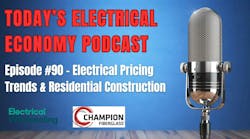Purchasing Managers Index slips in January. The Institute for Supply Management, Tempe, Ariz., said the January Purchasing Managers Index registered 53.5%, a decrease of 1.6 percentage points from December’s seasonally adjusted reading of 55.1%. Any reading over 50 indicates a growth environment.
Conference Board’s Leading Indicators keep on growth track in December. The Conference Board Leading Economic Index (LEI) for the U.S. increased 0.5% in December to 121.1 (2010 = 100), following a 0.4% increase in November, and a 0.6% increase October. “December’s gain in the LEI was driven by a majority of its components, suggesting the short-term outlook is getting brighter and the economy continues to build momentum,” said Ataman Ozyildirim, a Conference Board economist.
Building permits see slight seasonal dip in January. Privately-owned housing units authorized by building permits in January were at a seasonally adjusted annual rate of 1,053,000, 0.7% below the revised December rate of 1,060,000, but 8.1% above the January 2014 estimate of 974,000. Single-family authorizations in January were at a rate of 654,000, 3.1% below the revised December figure of 675,000. Permits for buildings with five-plus units were at a rate of 372,000 in January, up 3.3% from December.
ABI holds steady in January. Following nine months of positive billings, the Architecture Billings Index (ABI) showed no increase in design activity in January. As a leading economic indicator of construction activity, the ABI reflects the approximate nine- to twelve-month lead time between architecture billings and construction spending. The American Institute of Architects (AIA), Washington, D.C., reported the January ABI score was 49.9, down from a mark of 52.7 in December. This score reflects a very modest decrease in design services (any score above 50 indicates an increase in billings). “This easing in demand for design services is a bit of a surprise given the overall strength of the market over the past nine months,” said AIA Chief Economist Kermit Baker. “Likely some of this can be attributed to severe weather conditions in January. We will have a better sense if there is a reason for more serious concern over the next couple of months.”








